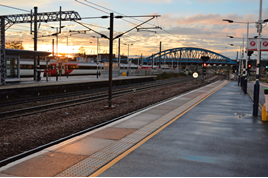“Even the best car in the world reaches a point where it is beyond what maintenance can do for it to consistently perform - then it’s time for a new one.”
Not the words of a savvy car salesman, but of Network Rail’s London North Eastern and East Midlands Route Managing Director Rob McIntosh, as he gazes out at the East Coast Main Line from the NR compound surrounding Doncaster Power Signal Box.
We are here to talk about the gleaming tracks located just a few metres away, but the motoring analogies continue for a moment longer before McIntosh swiftly brings the conversation back to reality, and the mammoth challenge he faces maintaining the performance of one of the country’s most critically important transport corridors.
“The ECML continues to serve its customers really well,” he says. “We maintain it, we renew it, but the assets are getting to the end of their lives and we need to plan for that. It if was a car, we would be talking about the chassis, the wiring loom and to an extent the engine. These are all bits you can change the oil in and keep going, but there comes a time when you have to buy a new one.”
McIntosh, who took over the role from the departing Phil Verster in January 2016, is in fact talking about the 40-year-old assets put in place during the electrification and route modernisation of the ECML, completed in the 1980s. Signals, cabling, power supply equipment and overhead wiring are all now reaching the end of their design lives, and increasingly beginning to show their age.
But with all eyes currently on NR’s painfully prolonged exertions to energise the Great Western Main Line, and the promise of flagship multi-billion-pound new build projects such as East West Rail and HS2, McIntosh feels that the day-to-day operational issues have been rather neglected of late.
The ECML RMD has his fair share of headline-grabbing capacity enhancements projects lined up for delivery on his own patch in Control Period 6 (April 1 2019-March 31 2024), but feels they may well fail to live up to expectations unless more fundamental issues are looked at as well.
Schemes are planned to remove major bottlenecks at the King’s Cross and York North station throats, while reinstating a fourth track between Woodwalton and Huntingdon and putting in a flyover at Werrington will also help raise punctuality on the Anglo-Scottish route, to levels never previously seen. But all will be in vain, he adds, if additional investment is not forthcoming in other areas.
“I think people have been too focused on enhancements to deliver capacity, without taking a step back to consider the state of assets in between and if they can deliver the service level performance that we need.
“We’ve been talking too much about enhancement and not enough about the infrastructure and its resilience. We need to take a step back and realise that the infrastructure is 40 years old and we’ve had some great use out of it. We’re still looking after it, but there comes a point where the underlying asset will continue to deteriorate.
“The VTEC franchise has to hit 90ppm in its last two years (2021-23), and it would seem naive to think that we’re going to deliver that without a significant level of investment in the assets.”
















Login to comment
Comments
No comments have been made yet.